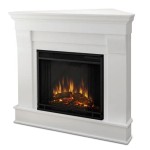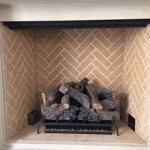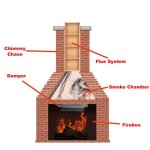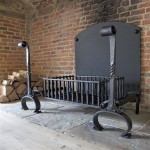Concrete Block Fireplace: A Durable and Versatile Hearth Option
The concrete block fireplace, also known as a cinder block fireplace, represents a practical and increasingly popular alternative to traditional brick or stone fireplaces. Its appeal lies in its affordability, structural integrity, and the freedom it offers in terms of design customization. While often considered a more utilitarian choice, advancements in finishing techniques and design approaches have elevated the concrete block fireplace, making it a viable and aesthetically pleasing option for a variety of architectural styles.
Understanding the characteristics and construction of a concrete block fireplace is essential for homeowners considering this option. This article will delve into the key aspects of concrete block fireplaces, including their benefits, design considerations, construction process, and finishing possibilities. This information aims to provide a comprehensive overview to facilitate informed decision-making.
Cost-Effectiveness and Durability
One of the primary advantages of a concrete block fireplace is its cost-effectiveness. Concrete blocks are significantly less expensive than bricks or natural stone, making them an appealing choice for budget-conscious homeowners. The savings extend beyond the material cost, as the installation process can also be more streamlined, potentially reducing labor expenses.
Durability is another key attribute. Concrete blocks possess inherent strength and resistance to heat, making them well-suited for the demands of a fireplace structure. They are also resistant to damage from moisture and pests, contributing to the long-term integrity of the fireplace. A properly constructed concrete block fireplace can withstand years of use with minimal maintenance.
Furthermore, the thermal mass of concrete blocks provides efficient heat retention. Once heated, the blocks radiate warmth into the surrounding space, contributing to energy efficiency. This characteristic can be particularly beneficial in colder climates where supplemental heating is often required.
Design Flexibility and Customization Options
Contrary to the perception of being purely functional, concrete block fireplaces offer considerable design flexibility. The modular nature of concrete blocks allows for a variety of configurations and sizes. They can be easily cut and shaped to create custom designs that suit specific architectural requirements. From traditional rectangular fireplaces to more contemporary and sculptural designs, the possibilities are extensive.
The surface of a concrete block fireplace can be customized in numerous ways. A simple coat of paint can transform the appearance of the blocks, allowing them to blend seamlessly with the surrounding décor. Stucco is another popular option, providing a smooth and textured finish that can be further enhanced with color and detailing.
For a more natural look, concrete blocks can be faced with stone veneer or brick tiles. These materials impart the aesthetic appeal of a traditional fireplace without the higher cost. The application of veneers and tiles also allows for a greater degree of customization in terms of color, texture, and pattern.
The firebox itself can be a pre-fabricated metal insert or a custom-built masonry firebox. Pre-fabricated inserts offer ease of installation and often incorporate features such as airtight doors and efficient combustion systems. Custom-built fireboxes provide greater design flexibility and allow for the integration of features such as pizza ovens or grilling areas.
Construction Process and Safety Considerations
Building a concrete block fireplace requires a solid understanding of masonry techniques and adherence to local building codes. While some experienced DIY enthusiasts may undertake the project themselves, it is generally recommended to hire a qualified mason or contractor to ensure proper construction and safety.
The foundation is a critical element of the fireplace structure. It must be strong enough to support the weight of the concrete blocks, firebox, and chimney. A reinforced concrete slab is typically used as the foundation for a concrete block fireplace. The size and thickness of the slab will depend on the dimensions of the fireplace and the soil conditions.
The concrete blocks are laid in a staggered pattern, with mortar joints between each block. The mortar binds the blocks together and provides a weather-resistant seal. Reinforcement bars (rebar) are often incorporated into the mortar joints to increase the structural integrity of the fireplace, particularly in areas prone to seismic activity.
The firebox is the area where the fire is contained. It must be constructed with fire-resistant materials such as firebrick or refractory cement. The firebox should be sized appropriately for the intended use of the fireplace. The chimney is responsible for venting smoke and combustion gases safely out of the house. It must be constructed in accordance with local building codes and properly sized to ensure adequate draft.
Safety is paramount when building and using a concrete block fireplace. Fire codes dictate minimum clearances between the fireplace and combustible materials such as wood framing. Proper ventilation is also crucial to prevent the buildup of carbon monoxide, a potentially deadly gas. Regular inspections and maintenance are necessary to ensure the fireplace is operating safely and efficiently.
The chimney flue should be inspected annually for cracks, obstructions, and creosote buildup. Creosote is a flammable residue that can accumulate in the chimney flue, increasing the risk of a chimney fire. Regular cleaning of the chimney flue is recommended to remove creosote and prevent fires.
A properly installed and maintained concrete block fireplace can provide years of warmth and enjoyment. However, it is essential to prioritize safety and adhere to all applicable building codes and regulations.
The facing material is carefully chosen to integrate with the surrounding decor. Options range from simple painted surfaces for a minimalist look to elaborate stone veneers for a more rustic or traditional aesthetic. The choice of finish profoundly impacts the overall appearance and creates an opportunity to personalize the structure.
The firebox options are equally diverse, ranging from traditional masonry fireboxes constructed with firebrick to prefabricated metal inserts offering increased efficiency and safety features. Prefabricated inserts often incorporate features such as glass doors and controlled combustion systems, enhancing the fireplace's performance.
A significant aspect of the concrete block fireplace is the chimney. The chimney's design and implementation are critical for ensuring proper draft and mitigating the risk of smoke intrusion into the home. Local building codes and safety regulations mandate the chimney's construction, height, and materials. Proper insulation of the chimney is also critical to prevent condensation and promote adequate drafting in cold weather conditions.
Furthermore, consideration must be given to the fireplace's location within the home. Placement near load-bearing walls is frequently prudent, offering additional structural support. Adequate clearance from combustible materials is also imperative, adhering to stringent fire safety codes to minimize the chance of accidental fires.
The concrete block fireplace offers a practical and visually versatile solution for homeowners desiring a robust and aesthetically pleasing fireplace. Its inherent durability, design flexibility, and cost-effectiveness make it a desirable choice for new construction projects and home remodeling endeavors. By carefully considering design options, construction techniques, and safety concerns, homeowners can create a warm and inviting focal point that complements their home's architectural style and personal preferences.
Beyond the fundamental structural and safety aspects, the decorative potential of a concrete block fireplace should not be overlooked. With creative application of various finishing materials and thoughtful design choices, a concrete block fireplace can be transformed from a utilitarian structure into a stunning architectural feature. The interplay of textures, colors, and patterns can create a fireplace that authentically reflects the homeowner's aesthetic sensibilities.
The ongoing maintenance of a concrete block fireplace is crucial for ensuring its longevity and safe operation. Regular inspections of the firebox, chimney, and surrounding masonry are essential for detecting any signs of damage or deterioration. Timely repairs of cracks, spalling, or loose mortar can prevent more extensive problems from developing. Furthermore, periodic cleaning of the chimney flue is necessary to remove creosote accumulation and reduce the risk of chimney fires.
The integration of a concrete block fireplace into a contemporary home often involves incorporating modern design elements and energy-efficient features. For instance, a linear fireplace design with a minimalist concrete surround can create a sleek and sophisticated focal point. Alternatively, incorporating a high-efficiency fireplace insert with a sealed combustion system can enhance the fireplace's energy performance and reduce emissions.

Concrete Block Outdoor Fireplace

Outdoor Fireplace Gallery Cinder Block Fire Pit

Cinder Block Fireplace House Design Walls

Concrete Block Outdoor Fireplace

Build An Outdoor Fireplace The Shed

Chris Loves Julia Diy Outdoor Fireplace Home Sweet Homes

Semplice Outdoor Fireplace Kit Rcp Block Brick

Cinder Block Outdoor Fireplace Plans Approximate Dimensions 10 Wide 5 Deep 8 Tall Backyard Diy

Santa Cruz Diy Outdoor Fireplace Plan 40 Pg New Zealand

Chris Loves Julia Diy Outdoor Fireplace Home Sweet Homes








